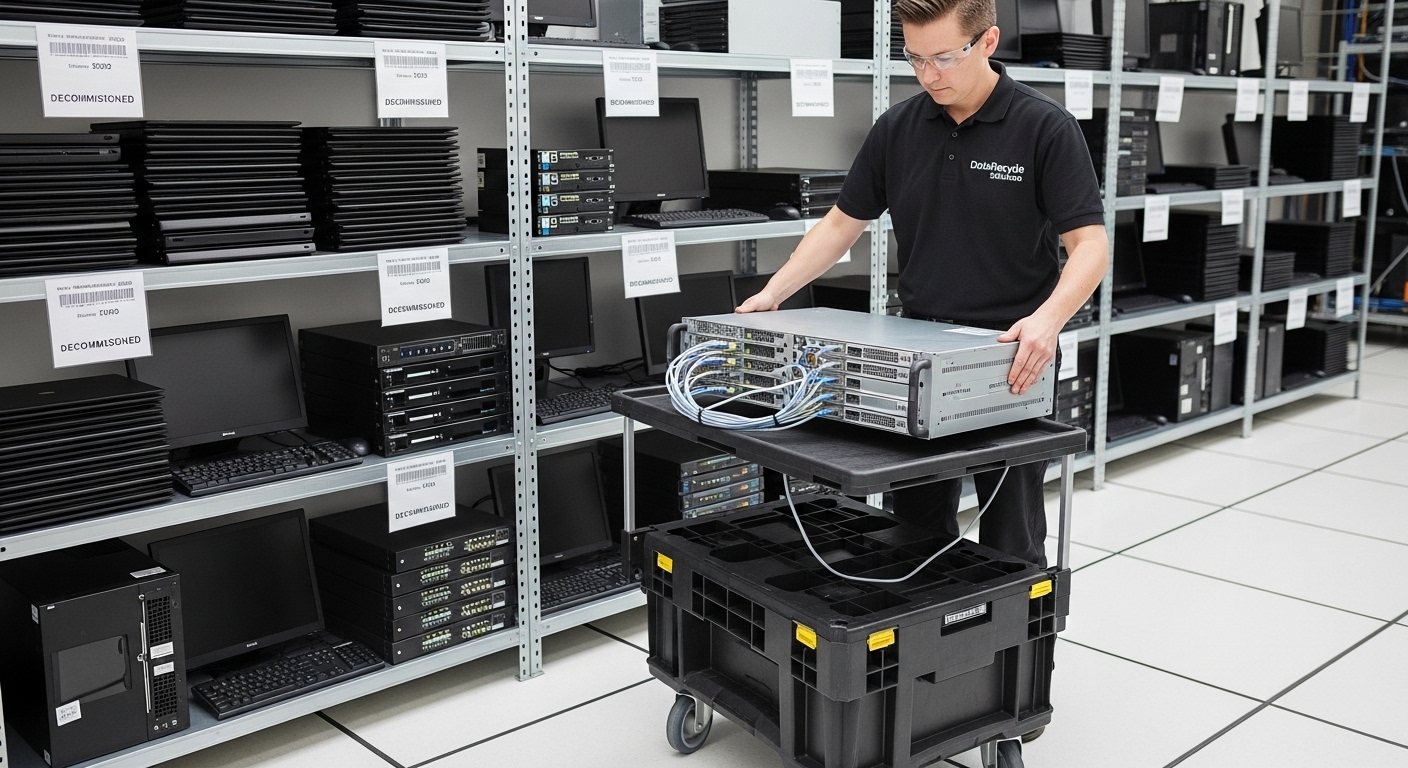When a company relocates, expands, or simply upgrades its technology, the focus is almost always on the new, shiny equipment. But what about the mountain of retired servers, laptops, and hard drives left behind? Too often, this process, known as IT decommissioning, is treated as an afterthought—a janitorial task of unplugging and hauling away. This oversight is a critical business risk. In today’s data-sensitive world, a single discarded hard drive can become a catastrophic data breach, while improper disposal can lead to steep environmental fines and reputational damage. A strategic approach to IT decommissioning, however, transforms this risk into an opportunity. It’s not just about throwing things away; it’s a disciplined process of data sanitization, value recovery, and compliant disposal. This guide provides a comprehensive playbook for breaking the circuit on old technology safely and effectively, covering crucial stages from initial planning and secure data erasure to maximizing value through asset disposition and ensuring environmental compliance.
The Decommissioning Blueprint: Why Planning is Paramount
The success or failure of any IT decommissioning project hinges on the quality of its initial plan. Rushing into the process without a clear strategy is a recipe for disaster, risking data leaks, operational oversights, and unexpected costs. A robust decommissioning blueprint begins with a comprehensive asset inventory. This isn’t a rough headcount; it’s a granular list of every piece of hardware to be retired, including servers, storage arrays, network switches, desktops, laptops, and mobile devices. Each item should be cataloged with its serial number, location, user, and, most importantly, whether it stores data. This inventory forms the foundation for all subsequent decisions. Once you know what you have, you can assign roles and responsibilities. Who is responsible for data backup? Who will oversee the physical removal of equipment? Who will manage the relationship with the disposal vendor? Clear ownership prevents critical tasks from falling through the cracks. The blueprint must also include a realistic timeline that aligns with broader business objectives, such as an office move or a new system go-live date. Rushing the process leads to mistakes, while delays can incur unnecessary costs for storage or leased space. By treating decommissioning with the same strategic rigor as any other IT project, you mitigate the inherent risks and set the stage for a secure and efficient transition.
The Digital Scrub: Mastering Data Sanitization Techniques
Simply deleting files or reformatting a hard drive is a dangerously inadequate method for protecting sensitive corporate data. These common actions only remove the pointers to the data, leaving the underlying information easily recoverable with widely available software. True data security requires complete data sanitization, a process that permanently and irreversibly removes information from a storage device. There are three primary methods for achieving this. The first, data overwriting, involves using specialized software to write patterns of ones and zeros over the entire drive, often in multiple passes. Standards like the DoD 5220.22-M specify the number of passes required for certified erasure. The second method is cryptographic erasure (CE), which is effective for self-encrypting drives (SEDs). This technique involves sanitizing the media by deleting the encryption key, rendering the encrypted data completely unreadable. The final and most absolute method is physical destruction. This involves degaussing, which uses a powerful magnetic field to destroy the data, or physical shredding, which grinds the hard drives and other media into tiny, unsalvageable pieces. The appropriate method depends on the data’s sensitivity, the device type, and internal security policies. For any organization, failing to properly sanitize data isn’t just a technical error; it’s a potential breach of compliance with regulations like GDPR, HIPAA, or CCPA, carrying severe financial and legal consequences.
Value Recovery: The Art of IT Asset Disposition (ITAD)
While security is the primary concern in decommissioning, it doesn’t mean retired IT assets are worthless. A strategic IT Asset Disposition (ITAD) program focuses on recovering the maximum possible value from this equipment, turning a cost center into a potential revenue stream. Not all assets are destined for the shredder. The first step is to triage the inventoried equipment. Newer, high-performance hardware, such as servers or laptops that are only a few years old, may have significant value on the secondary market. Partnering with a reputable ITAD vendor can facilitate this remarketing process, from valuation and cosmetic refurbishment to secure sales. For older or less valuable equipment, component harvesting can be a smart move. Memory modules, CPUs, and power supplies can be salvaged and used as spare parts for remaining systems, reducing future maintenance costs. Another popular option is to establish an employee purchase program, allowing staff to buy refurbished company laptops or monitors at a discounted price. This not only recovers value but also serves as a popular employee perk. The key to successful ITAD is accurate assessment and a trusted partnership. A good ITAD vendor provides transparent reporting on what was sold, for how much, and what was recycled, ensuring you can account for every asset and its final disposition.
The Green Goodbye: Navigating E-Waste and Environmental Compliance
The environmental impact of electronic waste, or e-waste, is a growing global concern. Discarded computers, monitors, and servers contain hazardous materials like lead, mercury, and cadmium, which can leach into soil and groundwater if sent to a landfill. Consequently, most jurisdictions have strict regulations governing the disposal of electronic equipment. A strategic decommissioning plan must prioritize environmental compliance not only to avoid fines but also to uphold corporate social responsibility. The most effective way to manage this is by partnering with a certified e-waste recycler. Look for vendors holding certifications like R2 (Responsible Recycling) or e-Stewards. These certifications ensure that the vendor adheres to the highest standards for environmental protection, data security, and worker safety. They guarantee that toxic materials are handled properly and that a zero-landfill policy is enforced, meaning all viable materials are recovered and re-used. A certified partner will provide you with Certificates of Recycling, which serve as legal proof that your assets were disposed of in an environmentally responsible manner. Choosing the right partner protects your company from legal liability and reinforces your brand’s commitment to sustainability—a factor of increasing importance to customers, investors, and employees alike.
Chain of Custody: Ensuring End-to-End Security and Documentation
From the moment an asset is unplugged to its final destruction or resale, maintaining an unbroken chain of custody is paramount for security and compliance. This logistical and documentary process tracks every asset at every stage, ensuring nothing is lost, stolen, or mishandled. The process begins on-site. Once data has been sanitized, assets should be tagged with serialized labels that correspond to the master inventory list. They should be stored in a secure, access-controlled area while awaiting pickup. When the ITAD vendor arrives, their personnel should verify the inventory against their pickup order before loading the assets into a secure, GPS-tracked vehicle. The transport containers themselves should be locked and sealed. Upon arrival at the vendor’s facility, the seals are inspected and broken in a secure, monitored environment, and the contents are once again reconciled against the manifest. This rigorous tracking is pointless without comprehensive documentation. Your ITAD partner must provide detailed reports, including a serialized list of all assets received, Certificates of Data Destruction for each sanitized drive, and Certificates of Recycling for disposed items. This documentation is your auditable proof that you have met all legal and regulatory obligations, providing a defensible record in case of any future security inquiry or compliance audit. Without a documented chain of custody, you are exposed to significant risk.
Beyond the Breaker: Integrating Decommissioning into the IT Lifecycle
Effective IT decommissioning should not be a reactive, one-time project triggered by an office move. Instead, it should be an integrated and continuous process within your overall IT Asset Management (ITAM) strategy. Viewing technology through its entire lifecycle—from procurement and deployment to maintenance, retirement, and disposal—creates a more efficient, secure, and cost-effective IT operation. When decommissioning is built into your ITAM framework, you gain a forward-looking perspective. You can anticipate refresh cycles and budget for disposal and replacement in advance, avoiding the surprise costs and logistical scrambles of a last-minute project. This proactive approach also enhances security posture. By continuously tracking the status and location of every asset, you reduce the risk of ‘ghost’ assets—devices that are lost or forgotten but may still contain sensitive data. Furthermore, integrating decommissioning data with procurement allows for smarter purchasing decisions based on total cost of ownership, including end-of-life value recovery. It transforms the process from a linear path ending in disposal to a circular system where the data from one lifecycle stage informs the next. This holistic view ensures that every piece of technology is managed securely and strategically from the moment it enters the building to the moment it leaves, truly closing the loop on IT management.
In conclusion, treating IT decommissioning as a mere cleanup task is a profound strategic error. The process is a critical control point for data security, financial management, and corporate reputation. By shifting perspective, organizations can transform this operational necessity into a strategic advantage. The core tenets are clear: begin with a meticulous plan and a detailed asset inventory. Prioritize the irreversible sanitization of all data to neutralize security threats. Embrace ITAD as a method to recover tangible value from retired hardware. Adhere strictly to environmental regulations by partnering with certified e-waste recyclers. Finally, enforce a rigorous chain of custody and demand comprehensive documentation to ensure end-to-end security and prove compliance. By embedding these practices into a continuous IT lifecycle management program, you move beyond the reactive ‘circuit breaker’ event. You create a resilient, secure, and sustainable system that protects your organization from hidden liabilities while unlocking the hidden value in the technology you no longer need. This isn’t just about ending a life cycle; it’s about intelligently preparing for the next one.





